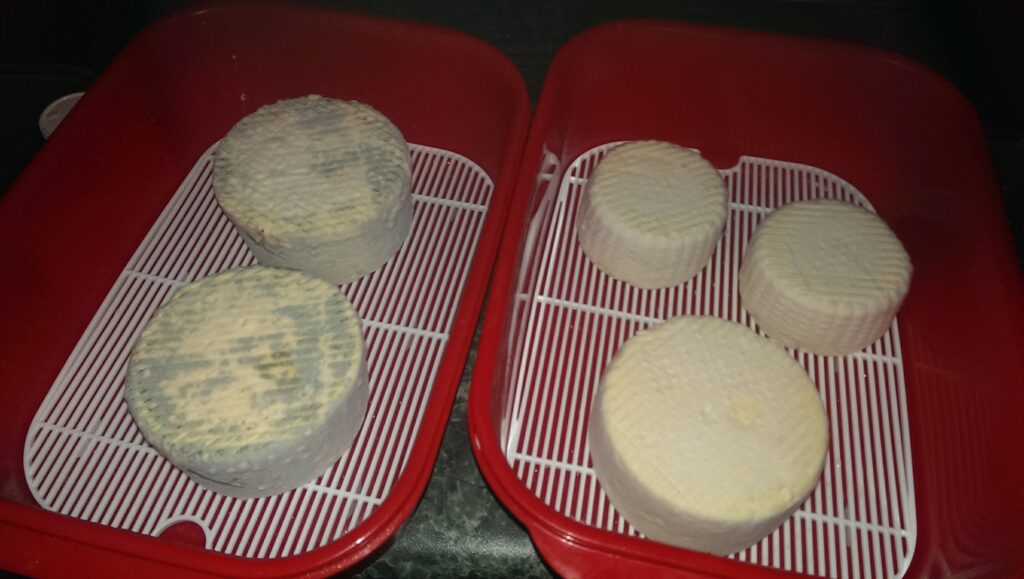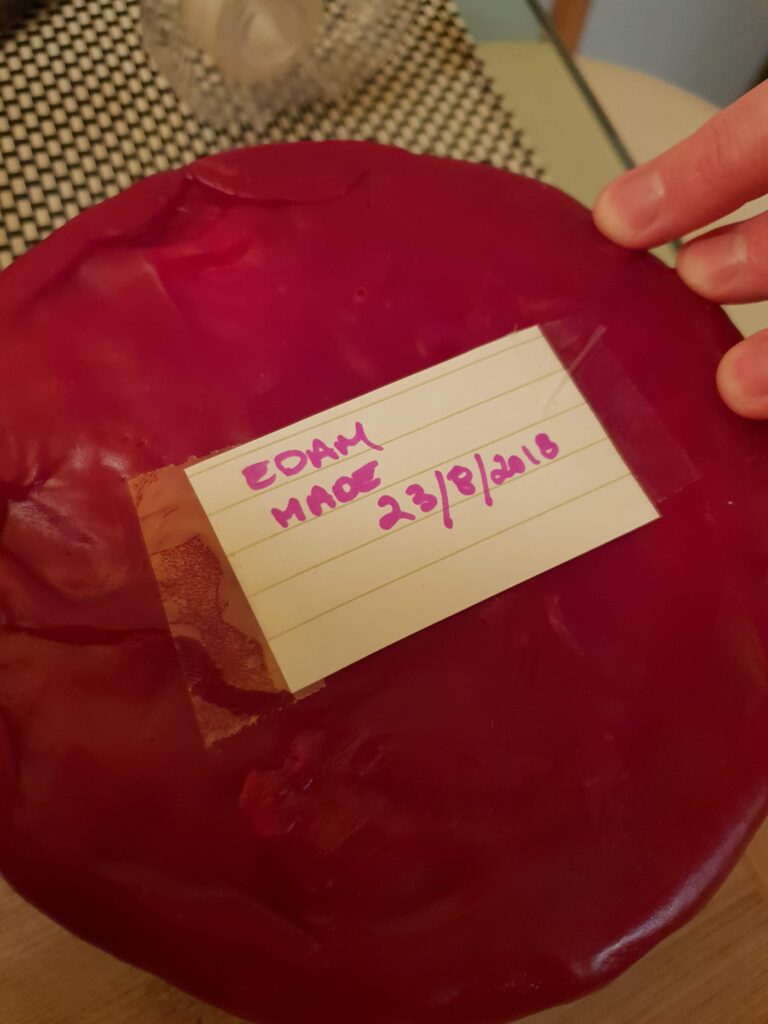One of my passions on land was making cheese. I don’t think it ever really worked out to be cheaper to make my own, nor would I say that I was particularly brilliant at it and should start my own factory, but it really was the process of making the cheese that brought me so much pleasure, not to mention the positive feedback. I also enjoy being a little more self sufficient and not relying on shops for some basic cheeses.
I would spend days making cheddar, then YEARS aging it, only to find out that I had added too much culture, or had the wrong ambient temperature in those first hours of making it and therefore years later the cheese tasted bitter. I never really cracked how to get good creamy tasting brie or camembert – but my blue cheese was divine. Slightly sweet with a tanginess and creaminess that melted in the mouth. My havarti was yummo, and I did manage to make one good cheddar.

Aged cheeses require 12 degrees celsius to age in, either for the few weeks needed for blue vein, or for the months for edam and years for cheddar. A wine fridge is fantastic for keeping the temperature of the cheese to around 12 degrees celcius which is perfect for aging and mould growth on white and blue mould cheese. It could be done on a boat with a cool box that is kept at 12 degrees with some ice bricks, but given how much else there is to do on a boat, swapping ice bricks in and out of a cool box twice a day wasn’t going to be something I could commit to ongoing.

I also spent time learning how to make fresh cheeses, and when my husband and I decided that we’d put in place a goal to cruise the world, I realised that fresh cheeses were going to be my goto, so I had better practice. So while we were still living on land, I practiced making fresh cheeses and using basic implements so that when we moved onto our 30ft monohull, I could still enjoy making and eating cheese.
How did I learn initially?
A journey of a thousand cheeses starts with a single google search… I found a local(ish) cheesemaker who also had a book available, plus could sell the supplies I needed. I bought the book and some starter supplies, and that was it! I soon found that I was making most of the cheeses in the book reasonably regularly, and writing all my own notes and corrections in the margins. Eventually I began to get frustrated with some of the inconsistencies in the book, and what I was perceiving to be a bit of an amateur production, so I started doing more googling, and modified a lot of the books recipes to my own liking, and also found a new supplier for ingredients that I feel are substantially better quality. I am planning on completing some courses with this company soon to hone my skills. The recipes here are based on my original learnings, googling, my own experimentation and bringing that all together to work on a boat. I will also update things on our blog as I learn.

What do I make on the boat?
Given my love of making complex cheeses, I do make a number of more advanced fresh cheeses as well as super basic cheeses that anyone could make. On my boat I make feta, yogurt, labne, paneer, ricotta and haloumi – all with powdered milk, and all with minimal equipment and cultures. I also am keen to begin experimenting with making cream cheeses such as mascarpone and quark.
I’d also love to make mozzarella, bocconcini and burrata but I just can’t spare the amount of water required to make these cheeses. We only have 100L available in the tank, no water maker, and these cheeses require multiple litres of water to make 1 round of mozzarella.
I did attempt making some chevre using some powdered goats milk and I can unequivocally say, this was gross and I won’t be doing it again. I’d use fresh goats milk for any further experimentation, or just purchase it when I see it!
I find I never buy yogurt, feta, haloumi or ricotta ever. I make it using either fresh milk when we are in port, or when I’m feeling particularly adventurous, I make it when we are anchored up in a remote place using powdered milk, and a little calcium chloride.
Using powdered milk
We use powdered milk in our tea and coffee and honestly its fine. I think whatever technology is going on these days to make it is stopping that sickly sweet but watery flavour coming through, rather it tastes almost creamy. It will never beat unhomogenised guernsey cow milk either in taste or texture, or for cheesemaking.
It is imperative however, that calcium chloride be included in your list of supplies, if you want to make some more interesting cheeses on your boat. The calcium chloride helps with setting the rennet correctly, by adding calcium to the milk which can bind to the fat molecules and create the curds and whey that we need to make cheese. I use 1ml in 10ml cooled boiled water for a 4L saucepan of milk.
What you might need
This is a list of what I have in our boat to make fresh cheese. Most, if not all of these items are available from home brew shops that also cater to cheesemakers, or online cheese shops. This list enables me to make any fresh cheese I like.
Cultures, ingredients and cleaners etc
- Yogurt culture (yogurt and labneh) – I prefer to have a small vial of culture in the freezer rather than using ¼ cup of yogurt as I can control the flavour more accurately ongoing. Reusing the yogurt over and over to make more yogurt introduces some other cultures and can result in some weird tasting stuff.
- Mesophilic starter culture (for feta and quark) – again this is a small vial in the freezer
- Lipase (for feta) – small vial in the freezer
- Thermophilic culture (mascarpone) – small vial in freezer
- Rennet (for setting milk to separate into curds and whey) – kept in the fridge
- Calcium Chloride (to help when trying to set powdered milk) – small vial also in fridge
- Citric acid
- Iodine based steriliser that is no rinse – small vial in fridge
Tools
- A cheesemaking vat that seconds as storage
- Square and round cheese molds
- Ricotta mold
- Measuring cup(s)
- Measuring spoons (measuring “tad”, “dash”, “smidgen”, “drop”)
- Cheesecloth
- Slotted spoon
- Curd knife
- Thermometer
- Kitchen scales
- Drainage rack and the container that it fits in
- Syringes
- Yogurt maker
- Colander
- Large saucepan
- Throw cushions that I used to keep the milk vat insulated and warm while the rennet separates the milk

